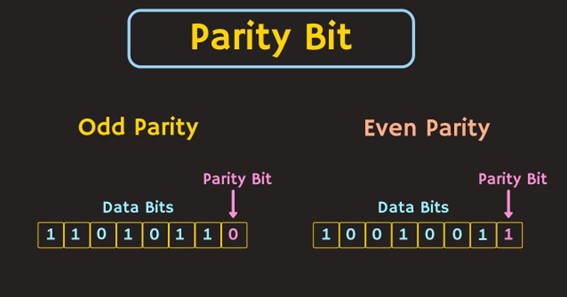If you are searching the information on even parity then here is the right place where you will come to understand everything about it. Here I will explain to you the meaning, examples, etc of it. You will know about the important points that are related to it. This will be helpful data that will provide you knowledge regarding the difference between even-odd parity. You would come to know what is the important points about the parity till the end. So let us start reading this information on what is even parity in the following.
What Is Even Parity?
Even parity is a parity testing mode of asynchronous communication networks in which an additional digit is used. This is digit is called a parity bit. It is set to zero if a one-byte data object has an even amount of one bit. If the sum of the one-bit values is an odd number, the parity bit is set to one. Besides, parity testing can be used to evaluate memory storage systems.
Even Parity Example
The parity bit’s value is determined using the data of the original parity. The binary value 10000000, for example, has odd parity. As a result, a 0 would be added to hold the parity odd, and a 1 would be added to make the value even. The values 1010 and 1001, for example, have the same parity.
Even Parity Bit
Parity bits are introduced to communications to determine that the number of bits with a value of one in a range adds up to even or odd numbers. The two parity checking forms are even and odd parities. The parity bit value is 0 while the number of 1s is even. The goal is to get an equal number of 1s. Here is an example, if you have a message signal “010,” you will see that it only has one 1. As a result, we apply a parity bit to make it two 1s. The number of 1s is now even.
Even Parity Check
It is a check that is used in memory storage unit testing. To make this work, the sender and receiver must agree to use parity even checking as the primary error detecting technique. Parity tests can detect data corruption if a single bit is changed during transmission. However, even parity key can fail to detect errors added when an even number of bits in the same data unit are altered due to electrical noises.
Even Parity Generator
This generator is a combinational circuit that helps transmit. It is the combinational logic circuit that helps to create the parity bit. The circuit consists of the transmitter that produces the parity bit. A parity checker, on the other hand, is a circuit that tests the parity in the receiver. In digital systems, a combination circuit or machines with parity generators and parity checkers are widely used to detect single-bit errors in the transmitted data name.
Even Parity Hamming Code
The hamming code for even of the parity is only there If the number of 1s is even and the parity bit value is 0. The parity bit value is 1 if the number of 1s is odd. In the case of odd parity, the parity bit value is 0 if the number of 1s is odd. The parity bit value is 1 if the number of 1s is even. The hamming code in this parity can be calculated alternately.
Following are the conditions that are used for calculating it.
- Assign parity bits to all bit locations that are powers of two.
- The other bit positions are for encoding data.
- Each parity bit evaluates the parity for a subset of the code word’s bits. The location of the parity bit specifies the sequence of bits that it tests and skips alternately.
- If the overall number of ones in the positions it checks is odd, set a parity bit to 1. If the total number of ones in the positions it checks is even, set a parity bit to 0.
Even Parity Bit Scheme
The parity bit in a parity even bit scheme is ‘0′ if there are an even number of 1s in the data stream and ‘1′ if there are an odd number of 1s in the data stream. This is a parity testing mode of asynchronous communication networks in which a special digit is used. There is a parity bit that is the number of the digit which is set to zero if a one-byte data object contains an even amount of one bit. If the sum of the one-bit values is an odd number, the parity bit is set to one.
Click here – Top 14 Best Things To Do In Monterey
Difference Between Even And Odd Parity
Here we have described the even vs odd parity difference in the following.
- In an even scheme, the parity bit is 1, if the number of 1s in the seven data bits is odd in comparison to the total number of eighth bits. The parity bit of an odd parity scheme is set equal to 1 if the number of 1s in the seven data bits is also out of the eighth bits.
- Even is resulting in an even number of 1s in the eight-bit byte. Odd parity is resulting in an odd number of 1s in the eight-bit byte.
- In the even scheme parity, the number of 1s in the data is even and it is set to 0. Whereas the number of 1s in the data is odd and it is set to 0 then the scheme is odd.
3-Bit Even Parity Circuit
Assume we are at the transmitting end and have a 3-bit message signal that we want to send with an even parity bit. Let A, B, and C be the input bits and P be the output bit that is even parity. Also, parity is created as a result of the message bit’s number of ones being calculated. If the number of 1s is even, the parity bit P is set to 0, and if it is odd, the parity bit P is set to 1. Following is an even parity truth table. Have a look at it.
4-Bit Even Parity Generator Using Multiplexer
If we had four input-bit message signals instead of three, we will have four message signals. The parity bit, which is produced at the output end P, is the product of the message signal’s input bits A, B, C, and D. Using the Sum-of-Products rule, solve the truth table for all cases where P is 1. This P is equal to the sum of A, B, C, and D.
Read Also: Top 10 Uses Of Metals And Their Properties
FAQ
What Are Even Parity And Odd Parity?
Below we have mentioned the even and odd parity in general.
- In an even scheme, the parity bit is 1, if the number of 1s in the seven data bits is odd in comparison to the total number of eighth bits. The parity bit of an odd parity scheme is set equal to 1 if the number of 1s in the seven data bits is also out of the eighth bits.
- Even is resulting in an even number of 1s in the eight-bit byte. Odd parity is resulting in an odd number of 1s in the eight-bit byte.
- In the even scheme, the number of 1s in the data is even and it is set to 0. Whereas the number of 1s in the data is odd and it is set to 0 then the scheme is odd.
How Do You Calculate Odd And Even Parity?
You can calculate even and odd parity by the following method.
- Even is calculated if the number of 1s is even, the parity bit value is 0. When the number of 1s is odd, the parity bit size is 1.
- In the case of odd parity, if the number of ones is odd, the parity bit value is 0. When the number of 1s is even, the parity bit size is 1.
What Does Odd Parity Mean?
Odd parity relates to parity testing methods of asynchronous communication networks in which each series of transmitted bits has an odd number of bits. Odd parity occurs when the overall number of ones in the data plus the parity bit is an odd number of ones.
Which Code Has Even Parity?
In this case, if the parity is even, the number of 1s for a given range of bits is counted. The parity bit value is set to 1 if the count is odd. This code is resulting in an even overall number of situations of 1s. If the overall number of 1s in a given bit set is already even and the count of the parity bits is 0.
What Is Even Parity Hamming Code?
Even parity bit: In the case of even parity, for a given set of bits, the number of 1’s are counted. If that count is odd, the parity bit value is set to 1, making the total count of occurrences of 1’s an even number. If the total number of 1’s in a given set of bits is already even, the parity bit’s value is 0.
What Is Meant By Odd Parity?
What Does Odd Parity Mean? In asynchronous communication systems, odd parity refers to parity checking modes, where each set of transmitted bits has an odd number of bits. If the total number of ones in the data plus the parity bit is an odd number of ones, it is called odd parity.
Is Odd Parity 1 Or 0?
If that count is odd, the parity bit value is set to 1, making the total count of occurrences of 1s in the whole set (including the parity bit) an even number. If the count of 1s in a given set of bits is already even, the parity bit’s value is 0.
Which Is Better Odd Parity Or Even Parity?
When the total number of transmitted bits, including the parity bit, is even, odd parity has the advantage that the all-zeros and all-ones patterns are both detected as errors.
How Do You Determine Even Parity?
Calculating a parity bit, even or odd, is a straightforward thing to do. For odd parity, count the 1s in the message, and if their number is even, add a 1 at a specified position; otherwise, add a 0. For even parity, do the opposite: if the number of 1s is even, add a 0; otherwise, add a 1
Read Also: What Is Server Inventory?
Conclusion
Now you have understood what is even parity means. In this information, we saw the important terms and points that are related to the parity. I discussed with you about the even and odd parity. You came to know the difference while reading this data. Here you found that how will it help you in knowing the parity of the computer. You would also have liked to read about the frequently asked questions above which will help you to get a clear idea of the parity. So overall you learned about the even parity in detail.
What do you mean by even parity
What does even parity mean?






